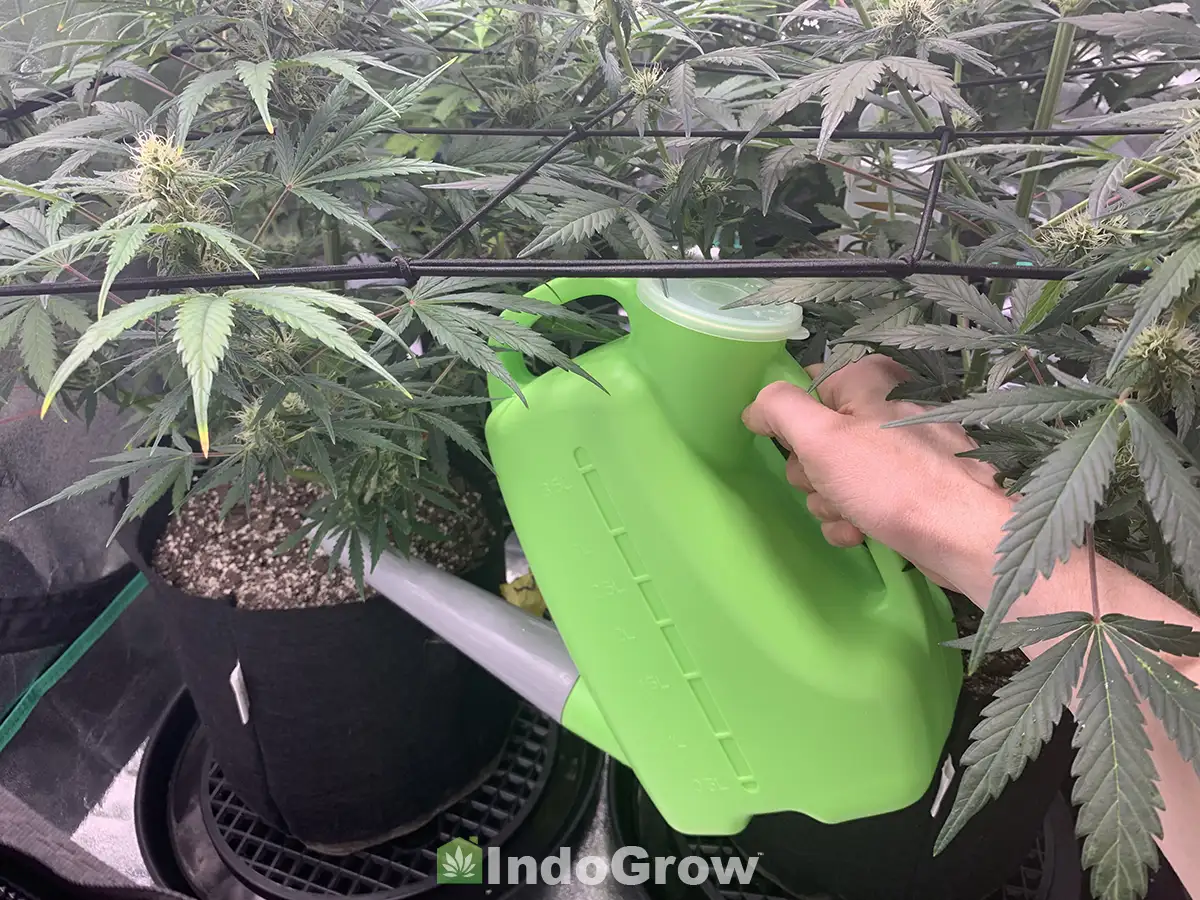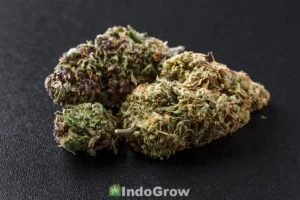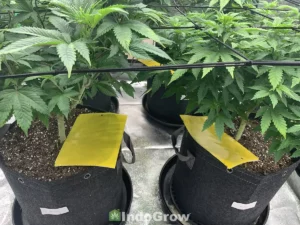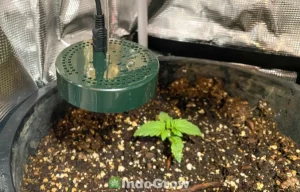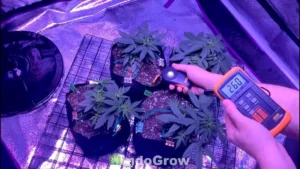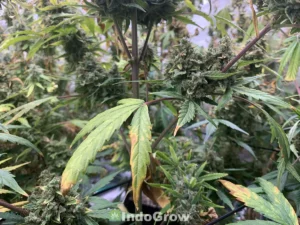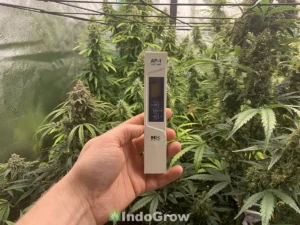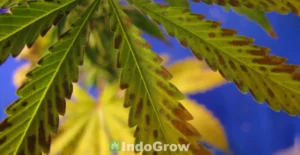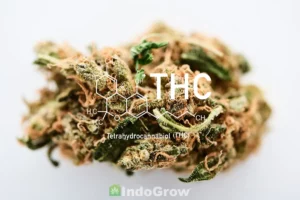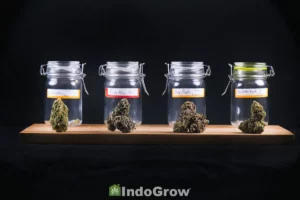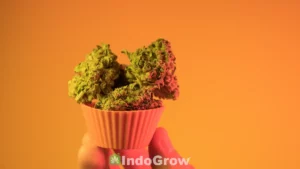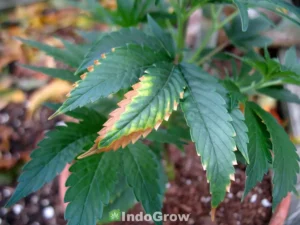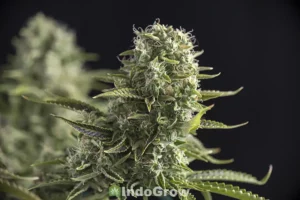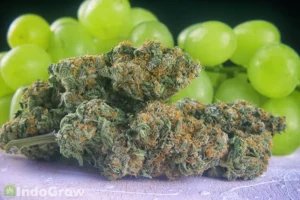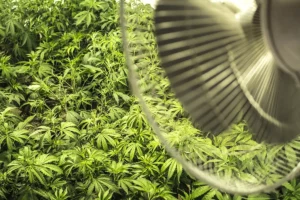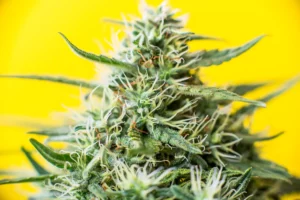Learning how to water cannabis plants properly is essential for a healthy harvest. Too little water will stunt your plants, while too much can lead to poor root health and fungal or bacterial infections.
Equally important is the nutrient content and pH of the water you use. This article will discuss the best watering methods for cannabis in both soil and hydroponics systems, as well as how to optimize the nutrient content and pH of your water.
Table of Contents
- How to Water Cannabis in Soil
- How to Water Cannabis Seedlings in Solo Cups?
- How Often to Water Cannabis in 3 Gallon Fabric Pots?
- How Often to Water Cannabis in 5 Gallon Fabric Pots?
- Factors that Affect How Often to Water in Soil
- Top Feeding Watering System
- Bottom Feeding Watering System
- Drain to Waste Systems
- Recirculating Systems
- Watering when Using Synthetic Nutrients
- Watering when Using Organic Nutrients
- Watering with Hydroponic Systems
- Adjusting Water pH
- How to Mix Cannabis Nutrients in Water
- Water Cannabis at Night or During Day?
- Adding Hydrogen Peroxide to Water
- Oxygenating Water
- Checking PPM/EC
- Reverse Osmosis Water
- Conclusion
How to Water Cannabis in Soil
The composition of your soil is an important consideration when watering marijuana plants. Cannabis should be grown in airy, fast draining soil that feels dry to the touch within 2-3 days after a watering. Using premixed soil varieties such as FoxFarms Ocean Forest, FoxFarms Happy Frog, or Promix HP will ensure that your soil has the proper consistency and nutritional profile for growing cannabis.
You can also create your own soil blend at home. Additives such as perlite and coco coir will reduce water retention and lead to faster drying soil, while heavier additives such as compost will increase water retention.
If your soil is taking more than 5 days to dry between waterings, or water is not flowing out of the drainage holes within a couple minutes of watering, your soil is likely holding too much water. Adding perlite or coco coir and checking for blockages in the drainage holes should increase water flow through the substrate.
How to Water Cannabis Seedlings in Solo Cups?
When using Ocean Forest, Happy Farm, HP Promix, or similar, seedlings in solo cups should be watered until runoff every 5 days during the first 2 weeks, then every 4 days until transplant. In other words, water when first planting, wait 5 days and water again, wait 5 more days and water again, then water every 4 days until transplant.
Be sure to make plenty of holes in the base of the solo cup before planting so that water doesn’t pool in the bottom. Seedlings will be ready to move to a larger container after 14-21 days.
How Often to Water Cannabis in 3 Gallon Fabric Pots?
Water cannabis plants in 3 gallon fabric pots every 2-5 days. Before watering, use either a moisture meter or your finger to test the top inch or so of soil in the pot. If the soil is obviously dry, proceed with watering. If the soil feels moist at all, hold off on watering and test again the next day.
When starting auto seedlings in 3 gallon fabric pots, follow the same instructions as for seedlings in solo cups. Water the seedlings every 5 days until runoff for the first two weeks after planting, then every 4 days until week 5. After this, water the plant approximately every 3 days until harvest. Some strains may require watering every 2 days during flowering.
How Often to Water Cannabis in 5 Gallon Fabric Pots?
Water marijuana plants in 5 gallon fabric pots every 2-5 days. Before watering, use either a moisture meter or your finger to test the top inch or so of soil in the pot. If the soil is obviously dry, proceed with watering. If the soil feels moist at all, hold off on watering and test again the next day.
If you have recently transplanted from a 1 gallon pot, start by watering every 4-5 days, then gradually increase to every 3 days during flowering. Cannabis grown in a 5 gallon pot should not need to be watered more often than every 3 days.
Autoflowers started in 5 gallon pots instead of 3 gallons may need more than 5 days to dry out between waterings for the first couple weeks, as their root mass will be very small compared to the pot size.
Factors that Affect How Often to Water in Soil
Factors such as growing medium, plant size, pot size, pot material, and environment can all play a role in how often to water cannabis plants.
The water retention abilities of your growing medium play a major role in how often you need to water weed plants. Coco coir dries out considerably faster than soil, so pure coco mixes or coco/soil mixes will need more frequent watering than soil alone.
Peat moss is another popular soil additive for cannabis, but it can be resistant to absorbing water at first. Soaking your peat moss in a tray of water for at least a week before adding it to a soil mixture will make the moss far more absorbent.
Another important consideration is the size of your cannabis plant and the size of its pot. Larger plants will consume greater quantities of water, and larger pots will be able to hold more water.
A plant that has fully colonized its pot with roots will need to be watered considerably more often than a plant that has just been moved into a new pot. With smaller plants in large pots, you must be especially careful not to allow the soil to become waterlogged, as this can limit oxygen and significantly increase the risk of root rot and slow plant growth.
The material your pot is made of also affects cannabis watering frequency. Fabric pots provide lots of healthy airflow to the soil and must be watered more often than solid pots due to increased evaporation. Solid pots such as terracotta or plastic hold water longer, and must be watered less often to allow soil to dry between waterings.
Environmental factors can also influence how often you must water marijuana plants. Hot, dry air will dry out soil faster, and also cause plants to consume more water through transpiration. In cooler, dryer conditions, soil will remain wet longer and plants will have slowed transpiration rates.
Top Feeding Watering System
Watering cannabis plants from the top of the soil is the most common and foolproof method of watering. Many home growers simply use a watering can to saturate the soil until runoff occurs. This is a particularly quick and easy method for small numbers of plants.
For larger numbers of plants, you may wish to set up a partially or fully automated watering system. For an automated system, you will need a fresh water reservoir such as a trash can or cooler with an air stone and water pump, as well as tubing and drip rings leading to the top of each pot. The pump can be attached to a timer to release water at specific intervals. You will likely also need a pump to remove runoff water to a separate waste reservoir.
Bottom Feeding Watering System
For bottom feeding cannabis plants, fabric pots are placed in a reservoir and water is added to the reservoir. The water slowly soaks into the soil, allowing the plants to drink as much water as they want. The reservoir can be refilled manually or by using an automated system such as the one described previously.
This type of watering can be very effective when done properly, but has its own risks and benefits compared to top feeding. For bottom fed plants, an occasional top watering can help flush out nutrient salt build ups and prevent a hard crust from forming on the top of the soil.
Drain to Waste Systems
This type of cannabis watering system is used with top feeding and is recommended for plants grown in soil. In a drain to waste system, runoff water is drained from the drip tray and discarded instead of being reused. This system prevents nutrient salts from building up in the growing medium.
Recirculating Systems
In a recirculating system, runoff water is reused instead of being discarded. This practice is most common in hydroponics systems. Although it can be very efficient, recirculating water can lead to increased bacteria and fungi in soil systems, so caution is warranted. Recirculating should not be done in coco/soil systems, as it can also throw off the nutrient balance in the medium.
Watering when Using Synthetic Nutrients
Liquid nutrients should be added directly to the water before adjusting pH, as the nutrients may alter the pH reading themselves. For best results, liquid nutrients should be used often, typically every other watering. When using liquid nutrients to water cannabis, be sure to water until runoff to prevent mineral salt buildup.
Watering when Using Organic Nutrients
Organic nutrients are typically sold as a powder or granule and added to the soil as a top dressing. Many organic nutrients release slowly into the soil and only need to be applied a few times over the plant’s lifetime. These nutrients are a great choice for automated watering systems, since you won’t need to worry about mixing nutrients into your water reservoir or preventing clogged tubes.
5% Watering Method
This alternative marijuana watering method involves watering approximately 5% of your pot’s volume every day. This method is popular for organic “live soil” grows, as keeping the soil consistently moist provides a more hospitable environment for beneficial soil microbes.
Keep in mind when calculating the amount to water each day that nursery pot sizes in gallons are not the same as true gallons. For instance, a 5 gallon nursery pot actually has a volume of 3.9 gallons. 5% of 3.9 gallons is 0.195 gallons, or about 25 ounces of water. The exact amount of water can be adjusted according to your needs, with the objective being consistently moist but not muddy soil.
Watering with Hydroponic Systems
Deep Water Culture (DWC)
This classic hydroponics method involves placing a single plant into a reservoir of water, with the roots suspended in the water using netting or pebbles. Nutrients are added to the water in the reservoir, which must be changed every couple days to prevent microbial growth. This method is a good choice for growing small numbers of plants, and the individual reservoirs prevent disease from spreading between plants.
Recirculating Deep Water Culture (RDWC)
This method is similar to DWC, except that the plants are connected via tubes to a single community reservoir. This method is far more efficient for larger grows, since water chemistry is consistent for every plant, although plant health and water quality must be monitored carefully to prevent pathogens from multiplying in the water system. Nutrients are added to the reservoir about once per week and circulated through the system to the plants.
Adjusting Water pH
After adding the desired nutrients to your water, use a pH testing meter to determine the water pH. pH up or pH down solutions can be added to the water if pH is outside the ideal range (5.8-6.2 for soil or 5.5-6.0 for hydroponics). Test water again after adding the pH solution, then water the cannabis.
Runoff water should also be pH tested regularly to determine the current soil pH. If the runoff water’s pH is outside of ideal range, adjust the watering pH accordingly to bring it back into healthy range. Improper soil pH can cause nutrient lockout and is a major cause of nutrient deficiency symptoms.
How to Mix Cannabis Nutrients in Water
When adding nutrients, always read the manufacturers guidelines closely. Some nutrients must be added to the water in a specific order to prevent chemical interactions between them. Never mix dry or concentrated liquid nutrients together, as this can also cause unintended reactions or prevent the mixture from dissolving properly.
If you are using a premixed NPK and CalMag fertilizer, the base NPK fertilizer should be added to the water before the CalMag. Any additional additives such as enzymes, humic acid, amino acids, etc should be added next. The major exception to this is Silica, which should be added 15-30 minutes before anything else to give it time to bond with the water.
PH adjusters should be added last, once all other additives are dissolved in the water, as some nutrients or other additives may affect the water’s pH level.
Water Cannabis at Night or During Day?
Cannabis plants should be watered in the morning or as early in the day as possible. Plants are most active during the day, quickly absorbing nutrients and water as needed. Watering at night results in slower uptake and increased chances of oxygen deprivation, harmful bacteria, and pests.
Watering frequency is much more important, however, so if you are only able to water at night or in the evenings, it should be fine. If you must water at night, you may see better result by changing your light schedule.
If you run your lights at night due to temperature issues, etc., then you should water soon after the lights come on. Even though it’s night for you, it’s still their morning.
Adding Hydrogen Peroxide to Water
A few drops to a couple mL of hydrogen peroxide per gallon of water is sometimes used to water marijuana, especially in hydroponic systems. Hydrogen peroxide is a highly reactive disinfectant that can kill fungal spores and bacteria in water. Hydrogen peroxide should be added to water before adding nutrients or adjusting pH for best results. Although it is only added to water in very small quantities, hydrogen peroxide has a highly alkaline pH of 11.75 and has the potential to raise the pH of your water.
Hydrogen peroxide should never be used in organic live soil grows, as the chemical will kill beneficial bacteria at the same rate as harmful bacteria. However, it can still be used as a general disinfectant for gardening tools when diluted 20:1 with water. Its short half life ensures that little to no hydrogen peroxide will remain by the time the tool dries.
Oxygenating Water
Adding an air stone or leaving water in an open container for 24 hours will oxygenate your water. While an air stone forces oxygen into the water rapidly, oxygen will also slowly dissolve into still water when left out for a sufficient period of time. Watering with oxygenated water will improve root health over time.
This aeration process also gives chlorine in tap water time to evaporate. Although small amounts of chlorine will not damage a plant, prolonged exposure can weaken the root system and kill off beneficial bacteria.
Checking PPM/EC
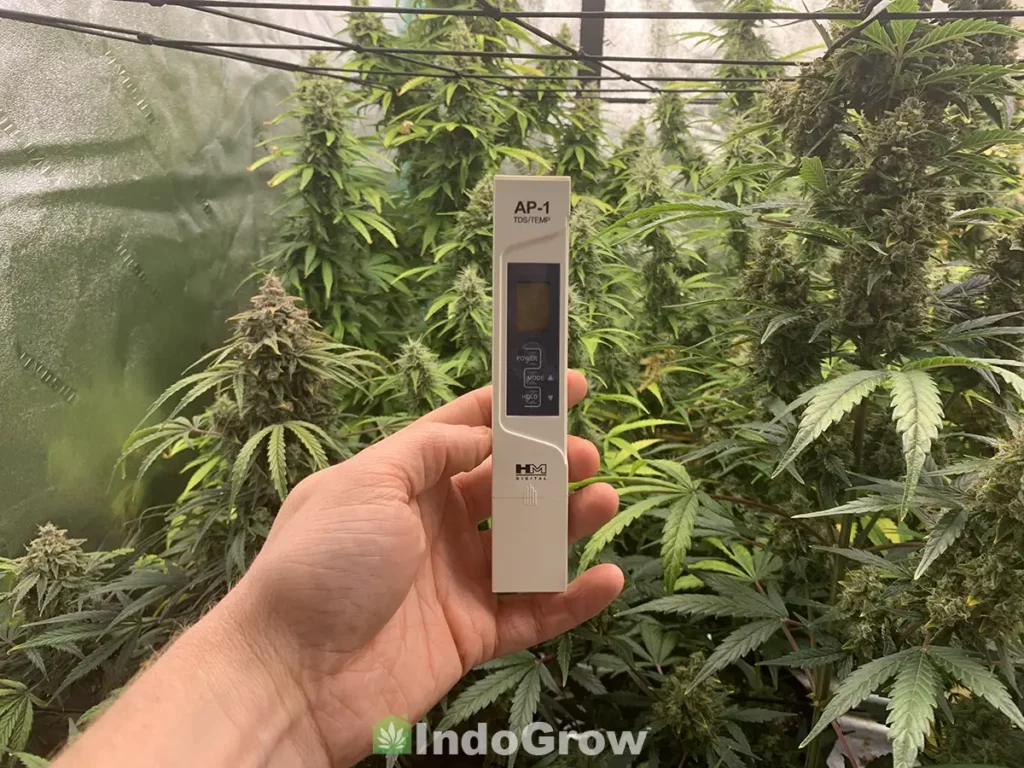
PPM or parts per million, is a measure of the total mineral concentration in your water. Cannabis can only uptake a finite amount of nutrients, so very high PPM has the potential to cause nutrient lockout. High PPM is often caused by hard water, so if your water’s base PPM is unusually high, you may need to feed your plants with a nutrient blend formulated for hard water. In comparison, reverse osmosis water and other soft water has an extremely low PPM and may require more nutrients than usual.
As plants age, their capacity to uptake nutrients increases. For seedlings, an ideal PPM ranges from 350-600 PPM. This increases to 600-900 PPM for vegetative plants and 900-1150 for flowering plants.
EC, or Electrical Conductivity, is a measure of the salinity of water. Similar to PPM, larger plants can tolerate higher EC levels as they age. Ideal EC levels are between .8-1.5 for seedlings, 1.5-1.9 for vegetative plants, and 1.9-2.2 for flowering plants.
PPM can be tested at home using a TDS meter, which stands for total dissolved solids, while EC can be tested using a conductivity tester.
Reverse Osmosis Water
Reverse Osmosis (RO) filters are often used to correct poor water quality. RO water is devoid of many dissolved minerals found in typical tap water and should only be used if you have hard water (high PPM). If you water cannabis with RO water, you will need to add additional CalMag supplementation to keep your plants from becoming deficient.
Conclusion
Many factors such as soil consistency, plant size, pot size and material, and environment affect the frequency of watering cannabis. Plants should generally be watered when their soil is dry to the touch but not dry all the way through. Nutrient blends and pH adjusters are often added to water to feed the plants and regulate their soil pH.

Rocky Horton
Author
Rocky Horton is an experienced cannabis grower and the founder of IndoGrow. The IndoGrow editorial team has over four decades of combined growing experience. Learn more.

